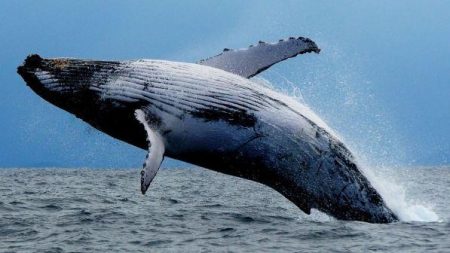Humpback whale adaptations.The humpback whale ( humpback whale , known in English as the humpback whale ) is a whale of Balenopteridae family and doing so the group of baleen whales; moreover, it is the only species of its genus . To get an idea of which are the closest relatives of the humpback whales, you can think of the fin whales (such as the common and the blue one), with which they share the family.



Humpback whale adaptations;5 Facts You Must Know.



1.These animals have many adaptations to life in water , to the point that their appearance reminds us of that of fish . This itself is an adaptation to the aquatic environment. Other adaptations of these cetaceans are not having much hair to prevent it from decreasing their swimming capacity and the speed of movement in the water. In addition, marine mammals have a thick layer of fat to insulate their bodies from the cold marine environment and thus prevent heat loss.
2.On the other hand, they present a series of physiological adaptations that allow them to submerge to quite great depths and for a long time. This is possible thanks to the fact that they have a blood volume greater than that of mammals of similar size and weight, and a greater capacity to store oxygen in the blood and in the muscles. It is also due to the fact that with each inspiration 90% of the air in the lungs is renewed compared to 15% in most terrestrial mammals.
3.Another reason is because these animals show a certain resistance to accumulate carbon dioxide in the tissues. For all these reasons, sperm whales can last more than an hour under water and baleen whales remain immersed for up to an hour. Thanks to these adaptations, the sperm whale when hunting for the giant squid tends to dive to depths greater than 400 meters.
4.The humpback whale lives in tropical and polar seas, preferring the waters near the coast.
To move from warm to cold waters, humpback whales make very long migrations in small herds of 15 individuals at the most. This is because in winter, when the polar waters are too cold and covered with ice, the animals move to warm waters to reproduce. When the cubs have grown up and summer is back, the animals move back to the poles where they will spend months feeding.
5.Humpback whales feed on invertebrates and small fish that they capture with a unique technique called “bubble net”. Having spotted a school of fish, the humpback whales surround it and swim around it, emitting bubbles from the blowhole. Thus trapped by the bubbles, the fish have no escape; the humpback whales dive and emerge with their mouths wide open, thus collecting the grouped fish.
6.The humpback whales among all the mysticetes are the ones that perform the greatest number of “acrobatics”: they roll, flap their fins on the water, emerge with the muzzle as if to look around, and, the only case among the mysticetes, are able to jump completely out of the water.
7.Humpback whales communicate by means of low-frequency sounds. These are very characteristic as they are organized in highly structured and complex songs.Each song is made up of a minimum of two to a maximum of nine different themes that follow one another in a precise order. Each chant can last from a few minutes to an hour and a half.
8. In any ocean basin, humpback whale populations sing the same song. Over time, the song gradually changes and all humpback whales around the world follow this change at the same time.
The songs are used by males during the breeding season, and are very effective calls, as they can be heard by a humpback whale even thousands of km away.
9.The name humpback whale , which translated from Greek means large wing , refers to the pectoral fins, which can reach lengths equal to 1/3 of the body: they are the longest pectoral fins among cetaceans [2] !
10.The average size of humpback whales is 15.6 m in length and 34 tons in weight [1 ] . In fact, like other whales, body length varies between males and females ( sexual dimorphism ): females are usually 1-1.5 m longer than males [3] .
11.Humpback whales are cetacean mammals and, as such, they are homeothermic , that is, they are able to maintain a constant body temperature. Like other mammals, moreover, humpback whales breathe air with their lungs: this pushes them towards the surface of the sea, where breathing is manifested by sprays through the blowhole (placed on the head and consisting of two openings). The immersion time of this species, in general, varies between 5 and 15 minutes .
Conclusion
The humpback whale adaptions is still an endangered species, as threats come not only from deliberate hunting, but also from chemical and noise pollution and collisions with boats. Although the size makes these animals look like indestructible giants, humpback whales live thanks to a delicate environmental and social balance. Their communication, as well as their movements, in fact, are mediated by sounds. In light of the foregoing, with hundreds of boats crossing the route of these giants disturbing their communication and movement, can we really consider them safe.